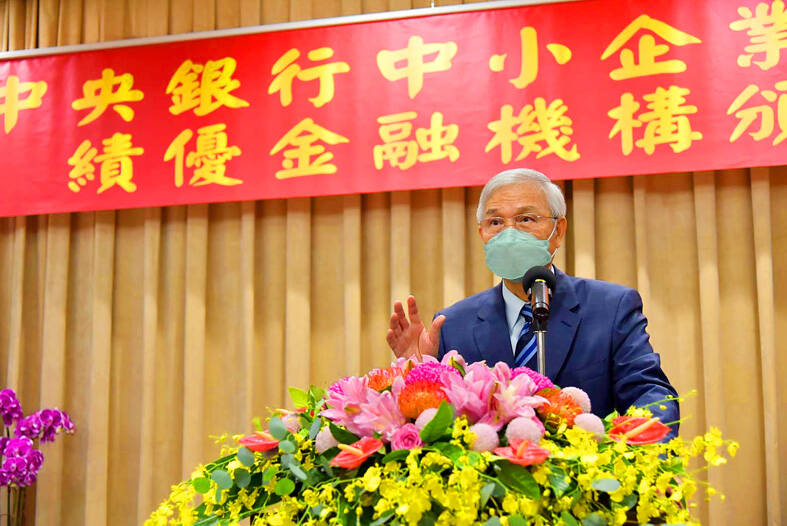A recently concluded special loan program provided a total of NT$503.58 billion (US$16.53 billion) in capital funding for 307,000 small and medium-sized enterprises (SMEs) affected by the COVID-19 pandemic, which was more effective than similar packages in other countries, central bank Governor Yang Chin-long (楊金龍) said yesterday.
Yang made the remarks during a public event to recognize lenders that participated in the program to help mitigate the pain inflicted by the pandemic.
The monetary policymaker spearheaded the lending program which offered preferential interest rates of between 1 percent and 1.5 percent from April 2020 to June this year when COVID-19 restrictions and infection fears wreaked havoc on retailers, restaurants, hotels and recreational facilities.

Photo courtesy of the central bank
Loans to SMEs grew 12.3 percent during the pandemic, much higher than the 5.9 percent increase for overall lending, allowing cash-stressed companies to stay afloat and retain their staff, Yang said.
“In a way, the loans played a substantial role in stabilizing the job market and supporting GDP growth,” the governor said, citing the economy’s expansion of 6.57 percent last year — an 11-year high — and 3.38 percent in the first half of this year, despite rising uncertainty.
The impressive economic showing gave the central bank the confidence to end the lending program and embark on monetary tightening to tame inflation.
Altogether, the number of workers hired by service-oriented sectors tumbled to 6.73 million at the height of the pandemic, but climbed to 6.81 million in June, Yang said.
Over the same period, people affected by furloughs and fewer working hours dropped from 56,000 to 21,000, he said.
To serve a maximum number of borrowers, the central bank made 15 adjustments to include cooperatives, fishers’ associations and farmers’ associations in the aid program and expand the loan scale from the original N$200 billion to NT$400 billion, Yang said.
While most US corporations raise fund through bond issuance and listings, domestic SMEs rely heavily on indirect financing — namely loans from banking institutions — for working capital, Yang said.
Indirect financing served 52 percent of SMEs and 63 percent of small businesses, whereas only 39 percent of large-cap companies needed capital injections, Yang said, adding that the special loans were a lifesaver during the pandemic.
The US introduced a similar Main Street Lending Program, but the loan granted accounted for only 3 percent of the total amount available due to high interest rate charges and low participation among lenders, he said.
The special loan program proceeded smoothly without raising bad loans and won approval from Fitch Ratings, Yang said.

The US dollar was trading at NT$29.7 at 10am today on the Taipei Foreign Exchange, as the New Taiwan dollar gained NT$1.364 from the previous close last week. The NT dollar continued to rise today, after surging 3.07 percent on Friday. After opening at NT$30.91, the NT dollar gained more than NT$1 in just 15 minutes, briefly passing the NT$30 mark. Before the US Department of the Treasury's semi-annual currency report came out, expectations that the NT dollar would keep rising were already building. The NT dollar on Friday closed at NT$31.064, up by NT$0.953 — a 3.07 percent single-day gain. Today,

‘SHORT TERM’: The local currency would likely remain strong in the near term, driven by anticipated US trade pressure, capital inflows and expectations of a US Fed rate cut The US dollar is expected to fall below NT$30 in the near term, as traders anticipate increased pressure from Washington for Taiwan to allow the New Taiwan dollar to appreciate, Cathay United Bank (國泰世華銀行) chief economist Lin Chi-chao (林啟超) said. Following a sharp drop in the greenback against the NT dollar on Friday, Lin told the Central News Agency that the local currency is likely to remain strong in the short term, driven in part by market psychology surrounding anticipated US policy pressure. On Friday, the US dollar fell NT$0.953, or 3.07 percent, closing at NT$31.064 — its lowest level since Jan.

Hong Kong authorities ramped up sales of the local dollar as the greenback’s slide threatened the foreign-exchange peg. The Hong Kong Monetary Authority (HKMA) sold a record HK$60.5 billion (US$7.8 billion) of the city’s currency, according to an alert sent on its Bloomberg page yesterday in Asia, after it tested the upper end of its trading band. That added to the HK$56.1 billion of sales versus the greenback since Friday. The rapid intervention signals efforts from the city’s authorities to limit the local currency’s moves within its HK$7.75 to HK$7.85 per US dollar trading band. Heavy sales of the local dollar by

The Financial Supervisory Commission (FSC) yesterday met with some of the nation’s largest insurance companies as a skyrocketing New Taiwan dollar piles pressure on their hundreds of billions of dollars in US bond investments. The commission has asked some life insurance firms, among the biggest Asian holders of US debt, to discuss how the rapidly strengthening NT dollar has impacted their operations, people familiar with the matter said. The meeting took place as the NT dollar jumped as much as 5 percent yesterday, its biggest intraday gain in more than three decades. The local currency surged as exporters rushed to